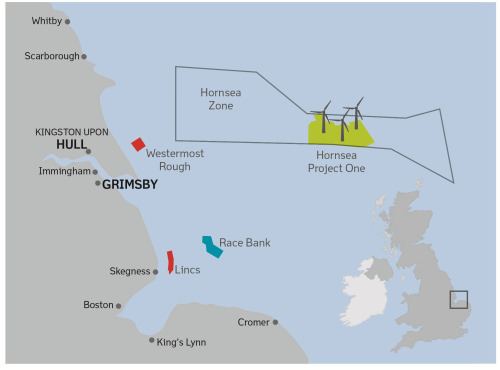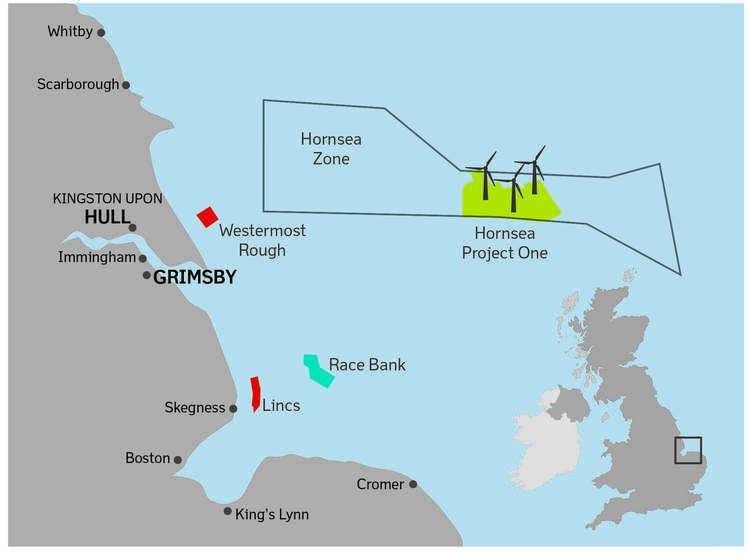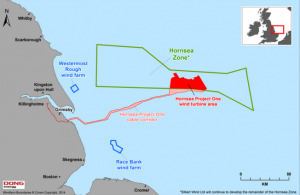Type Marine Planned completion date 2020 | Status Planning stage Start date 2010 Owner DONG Energy | |
 | ||
Nameplate capacity Project 1 : 1.2 GWProject 2 : 1.8 GW | ||
Hornsea Wind Farm is a Round 3 wind farm under planning development in the North Sea off the coast of England. The wind farm is planned to have a total capacity of up to 4 GW.
Contents

The development has been split into a number of subzones. The 1.2 GW Project 1 gained planning consent in 2014; a second 1.8 GW Project 2 was given planning consent in 2016. In 2016 a third subzone was split into two projects Hornsea 3 and 4, with approximate capacities of 1–2 GW and 1 GW, increasing the capacity of the developed project to a maximum of 6 GW.

History

The tendering process for Round 3 offshore wind farm opportunities was begun by the Crown Estate in 2008. Bids were received in March 2009, and Zone Development Agreements signed in December 2009. The Hornsea development zone was awarded to a joint venture (SMart Wind) of Siemens and a consortium Mainstream Power Renewals including Hochtief – the development had an estimated potential generating capacity of 4 GW.

The Hornsea site was one of three off the English coast in the North Sea, roughly halfway between the other two: Dogger Bank Wind Farm and East Anglia Wind Farm. The Hornsea site ('Zone 4', also known as 'Holderness' zone) had a total area of 4,730 square kilometres (1,830 sq mi), and was located 38 kilometres (24 mi) from land at the closest point; water depth in the zone was from 22 to 73 metres (72 to 240 ft), with a tidal range of 2 to 5 metres (6 ft 7 in to 16 ft 5 in), and typical annual wave height of 1.35 to 1.78 metres (4 ft 5 in to 5 ft 10 in). The surface seabed consisted primarily of sands and gravel.

In 2011 Dong Energy became a partner in SMart Wind. In early 2015 Dong became 100% owner of the first phase, Project 1, of the scheme. Dong acquired rights to the remaining subzones of the Hornsea development (2 & 3) by August 2015.
In 2016 Dong reached an agreement with the Crown estate for amended plans for the Hornsea Two and Hornsea Three phases. Hornsea Three was split into two new projects, Hornsea Three and Hornsea Four; the new phases were expected to be developed sometime in the 2020s. The changes increased the potential generating capacity of the windfarm to 6 GW, with Hornsea Three estimated at 1–2 GW and Hornsea Four generating about 1 GW.
Hornsea Project 1
The initial scoping report for "Project One" within the Hornsea zone identified it as a subzone of 629.6 square kilometres (243.1 sq mi) in the centre of the Hornsea zone, with an estimated potential wind farm of 1.2 GW, divided into two further subzones of 600 MW capacity each. The zone was to connect to an existing 400 kV National Grid substation at Killingholm. A variety of configurations were considered – foundations of pile jacket, monopile or gravity base; turbines from 3.6 to 8 MW rated power; with electrical power export by HVDC. Later Dong Energy added the consideration to use HVAC export cables. The chosen cable export was planned to make landfall at Horsehoe Point (northeast of Marshchapel, East Lindsey), then passing 40 kilometres (25 mi) west and northwest to a substation near Killingholme Power Station, North Killingholme in North Lincolnshire.
Within the zone of Project 1 the primary underlying geology consisted of deposits from the Quaternary Period consisting of Bolders bank, Botney Cut and Eem formations – primarily sediments or tills – gravelley/sandy clays, overlying sediments were sands or gravels up to 2 to 3 metres (6 ft 7 in to 9 ft 10 in) thick, with for sandwaves within the area varying in height by 1 to 3 metres (3 ft 3 in to 9 ft 10 in). Project 1 water depths were generally 25 to 30 metres (82 to 98 ft).
In 2011 Smart Wind signed lease agreements with the Crown Estate for "Heron Wind" and "Njord" areas making up the zone. The zone was given provisional contract for difference renewable subsidies by the UK government in April 2014. Hornsea Project 1 was given planning consent in December 2014. The 'contract for difference' strike price was £140 per MWh. In early 2015 Dong acquired all of the project, becoming 100% owner.
Seabed investigation including boreholes at turbine foundation positions was completed by Fugro by April 2015. In mid 2015 Dong selected Siemens Wind Power 7 MW turbines with 154 metres (505 ft) rotor turbines for the project – around 171 turbines would be used for the wind farm. In its 2015 financial report Dong stated it had chosen to use suction bucket foundations on a third of the turbines at Hornsea. Rational for use of the new foundation type are thought to be a simplified foundation installation, requiring only a heavy lift crane to lower the foundation to the sea bed, reducing costs.
Dong Energy formally committed to building the wind farm in early 2016. The expected completion date for the project was 2020. A £25million contract to construct the onshore substation at North Killingholme had been awarded to Balfour Beatty in late 2015.
NKT Cables (NKT Holding) and ABB were awarded €139 (c. $158) million and $250million contracts to supply 220kV AC export cables in March/April 2016. In late 2016 JDR Cables was contracted to supply 242 kilometres (150 mi) of inter-array subsea power cables for the wind farm; Nexans was awarded a contract for 139 kilometres (86 mi) of inter-array cables; and EEW was awarded a contract to supply 116 monopiles. Bladt Industries/Offshore Structures (Britain) Ltd. was awarded a contract for 96 tower transition pieces in early 2017, to be constructed at Aalborg, Denmark and Billingham, UK.
Construction of the onshore cable route was begun in late 2016 under J. Murphy & Sons.
The wind farm is scheduled to be constructed between 2018 and 2020, and expected to provide an annual production of around 4.1 TWh.
Hornsea Project 2
A scoping report for "Project Two" was published in October 2012. The subzone was expected to be developed in a number of phases, with a potential wind turbine capacity of 1.8 GW, in an area of around 400 square kilometres (150 sq mi) located in the centre of the Hornsea wind farm zone. Project 2 was use the same route for its electrical export cable as Project One, and to use either HVAC or HVDC with a separate onshore substation. Suitable areas for the Project 2 development were identified as being adjacent to the north, east or west of the Zone 1, which was located in the shallowest area of the whole Hornsea zone. The design considered piled, suction pile, monopile or gravity base foundations for wind turbines of 5 to 15 MW rated power.
As with Project 1 sea bed conditions and geology consisted of Quaternary period deposits, primarily sediments of sand, till and clays, with the overlying gravel or sand seabed including sandwaves, with the average water depth of 25 to 30 metres (82 to 98 ft).
In 2013 SMart wind signed lease agreements with the Crown Estate for the "Optimus Wind" and "Breesea" areas making up Project 2 of Hornsea wind farm. A planning application for Project 2 was submitted and accepted for examination in early 2015; its wind turbine area was located adjacent northwest of the Project 1 area, with the cable export route following that of Project 1 adjacent on the northward side. Planning permission for the development was awarded in August 2016.
Hornsea Project 3
Dong began consultation on the project three development in May 2016. Project 3 was to the east of Projects 1 and 2, with an estimated maximum capacity of 2.4GW over 696 square kilometres (269 sq mi); the initial planning schedule was consent application in 2018, and construction from 2022-25.
